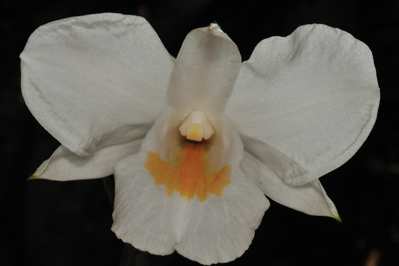Epiphyte. A pendulous plant with thick woody rhizomes and ovoid pseudo-bulbs arranged 4 to 5 cm apart. Bulbs 2 to 4 cm long partly covered with thin membranous sheaths. Leaves in pairs, oblong, with very short petioles or often sessile, 4 to 7 cm long and around 2 cm in width, apex notched. Flowers solitary, 2 to 3 cm across. Sepals and petals yellowish brown with many veins. Lip yellowish brown, edges of the side lobes with bright orange, apical lobe with a yellow triangle on its mid and the sides with dull purple colour, the base of the lip with two irregular bright orange markings. Sepals spreading, dorsal ovate to lanceolate, lateral pair slightly falcate. Petals narrower than the sepals, lanceolate, arching over the lip. Lip obovate-oblong, side lobes rounded, the disc with three lamellae, apical lobe slightly decurved.

The Pursuit
The most technically perfect orchid photograph of my entire career was of this species. This species even though not common can be easily located hanging down from huge trees in its habitats with very much ease. I found this plant three years earlier and studied it in its habitats. The authors King and Pantling described the flower as pale chestnut brown. While I was studying the flower, its unusual colouration attracted me. The flowers got bright orange stripes and markings, dull purple on its apical lobes and three distinctive bright yellow lamellae. Neither the authors in their monumental book nor any other books published later described those colourations in detail. As a challenge I took up the task of documenting the flower with all those details. The species was in plenty in that region. However, the plants pendulous growth, hanging down tall trees, always stand as a hurdle for precise photography. In the wind the pendulous stems swing to and fro causing great difficulty for my documentation work. The first hurdle was accomplished by finding a plant which was growing down a tree with its main trunk as its support. I selected comparatively a big flower (2.8 cm across!!!!). Studied it in detail to verify all the structures are intact and colouring pattern are perfect. Then the main task of arranging the lighting instruments was undertaken. As carrying several tripods to position flashes are very difficult, I often use locally available bamboos or broken branches from the forest. My intention was to use 8 micro flashes and 2 optical cable lightnings. Calculating the exact positions for each flashes and its angles inside a deep forest is not an easy task. My experience of working with those equipments and terrain always helped me in my field work. The task of taking several photographs, analysing them, rearranging the flashes at different angles to re-shoot, went on for long hours. Finally after a lot of efforts I got this perfect photograph of the species which captured the unknown characteristics of this flower.








